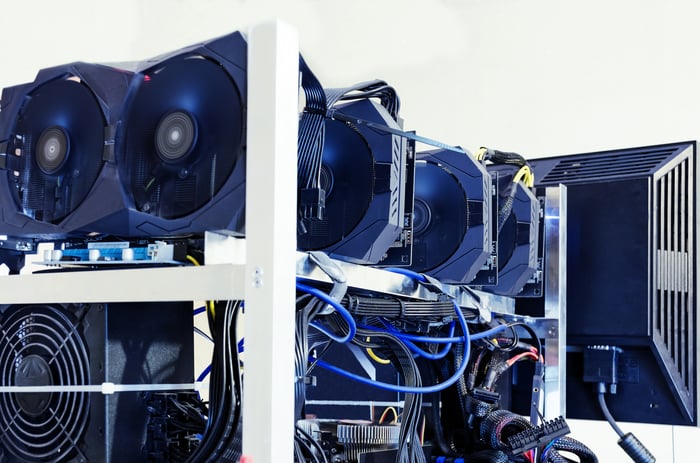Last year was nothing short of special for cryptocurrency investors. Having begun the year with a market value of less than $18 billion, the aggregate value of virtual currencies soared by more than 3,300%, or about $600 billion, by the time the calendar changed over to 2018. Investors who had the wherewithal to stick around were likely handsomely rewarded.
However, the exceptionally volatile nature of the nascent cryptocurrency market, compounded with the fact that it's unregulated in most countries around the globe, makes investing in digital currencies quite the chore. In other words, most folks would prefer some form of direct exposure to cryptocurrencies via the traditional stock market as opposed to having to jump through hoops by investing on a decentralized cryptocurrency exchange.

Image source: Getty Images.
But, truth be told, one stock can be purchased on the over-the-counter exchange that would give investors direct exposure to cryptocurrencies. Not only that, but it also announced a profit in its recently reported third-quarter operating results. Ladies and gentlemen, say hello to Vancouver, B.C.-based cryptocurrency mining firm HIVE Blockchain Technologies (HIVE).
What is cryptocurrency mining, and how is it profitable?
What the heck is cryptocurrency mining, you ask? Essentially, it describes an operation whereby a person, team, or business uses high-powered computers to solve complex mathematical equations to proof transactions conducted over a cryptocurrencies' blockchain (i.e., to ensure the same token wasn't spent twice). These equations are part of the encryption process designed to protect transactions from cybercriminals. These miners then compete with each other to be the first to solve these equations for a block of transactions. The first miner to do so is awarded with tokens for a given cryptocurrency as a reward (known as a block reward).
As an example, data from BitInfoCharts as of March 5, 2018 shows that 5,856 Ethereum blocks were proofed over a rolling 24-hour period. The average reward per block worked out to about 3.58 Ether tokens, which is worth just shy of $3,000. Assuming a person, group, or business was the first to have resolved a block on Ethereum's network, they'd have pocketed a good chunk of change. Across the 5,856 blocks over the trailing day, more than $17.5 million worth of Ether was rewarded. You can sort of see how this can be a profitable venture, if the cards fall your way.

Image source: Getty Images.
You see, cryptocurrency mining is a highly electricity-intensive model. The data centers that come complete with servers, graphics card units, or even ASIC chips for the special purpose of mining bitcoin, use a lot of electricity. Therefore, local electricity prices can have a big say on whether or not a mining operation will be profitable.
In a recently published report on bitcoin mining from Elite Fixtures that examined electricity costs in 115 countries, it was found that the average cost of mining a single bitcoin in Venezuela, where the country's energy industry is highly subsidized, is just $531. Meanwhile, mining a single bitcoin in South Korea, which has some of the highest electricity prices in the world, would cost north of $26,000! With bitcoin around $11,000 today, South Korean miners would lose money mining bitcoin.
HIVE turns a profit
Now that you have a better bead on what cryptocurrency mining entails, it'll make more sense when talking about HIVE Blockchain Technologies' results.
According to the company, it mines Ethereum, Ethereum Classic, and ZCash, among other cryptocurrencies, and wound up generating revenue of $3,274,186 during the third quarter. Keep in mind that this was the first real quarter of mining operations for the company, and it's still in the process of ramping up its mining operations in Iceland and Sweden, two countries with relatively low electricity costs.

Image source: Getty Images.
In total, mining margin at the Iceland facilities, which is where the aforementioned revenue came from, worked out to $2,382,687 (72.7%). In fact, for the time being the biggest expense for HIVE is share-based compensation. After accounting for operating costs, general and administrative expenses, and income tax expense, the company cleared $149,724 in profit. Admittedly, with 281.7 million diluted shares, that still works out to an EPS of $0.00. But a profit is a profit nonetheless.
HIVE is also retaining some of the digital currencies it mines, which could certainly have an impact on its future value. It ended the third quarter with $5,827,805 in digital currency assets, but notes that recent investments in new mining farms has boosted its virtual currency asset worth to $13,624,783 as of Feb. 26. What isn't clear is how much in the way of digital currencies HIVE plans to keep on its balance sheet at a given time, or what percentage it'll convert to U.S. dollars.
Lastly, capital raises, along with its aforementioned digital currency portfolio, have pushed its total assets to almost $164 million. This includes $99.1 million in cash. In short, HIVE Blockchain appears fully capable of expanding its mining presence and achieving what it believes is a full run-rate of $150 million in revenue a year, or about $3 million per week.

Image source: Getty Images.
Don't get too excited just yet
However, before you get too excited about having access to a pure-play cryptocurrency mining company, understand that there are plenty of risks involved.
First, take into account that HIVE Blockchain essentially had no upfront capital and has relied on bought-deal financings to raise cash. Though it's had little issue raising cash, these bought-deal offerings can dramatically increase the company's outstanding share count upfront and over time. For instance, a bought-deal offering closed in mid-November offered a share of common stock, along with a warrant to purchase another share of stock, via the private placement. If these warrants are executed in the future, that's more dilution heading shareholders' way. It could be very difficult at this rate for HIVE to generate anything meaningful in terms of earnings per share.
Also, HIVE's assets could fluctuate dramatically depending on how well or poorly the cryptocurrency market performs. Just a month ago, when digital currency prices collapsed 67% over the span of 30 days, HIVE's digital currency assets would have been worth much less, and its mining margins would certainly have taken a hit. In order to succeed, the company will need some form of stability, but is unlikely to find it.
Though this could be an intriguing story stock when its operations are fully ramped up, it is, for the time being, no place for investors' money.


